Synthesis Characterization and Photocatalytic Studies of Cobalt Ferrite-Silica-Titania Nanocomposites
Abstract
:1. Introduction
2. Results and Discussion
2.1. Synthesis and Characterization of CoFe2O4 Nanoparticles


2.2. Synthesis and Characterization of CoFe2O4/SiO2 Core-Shell Nanostructures
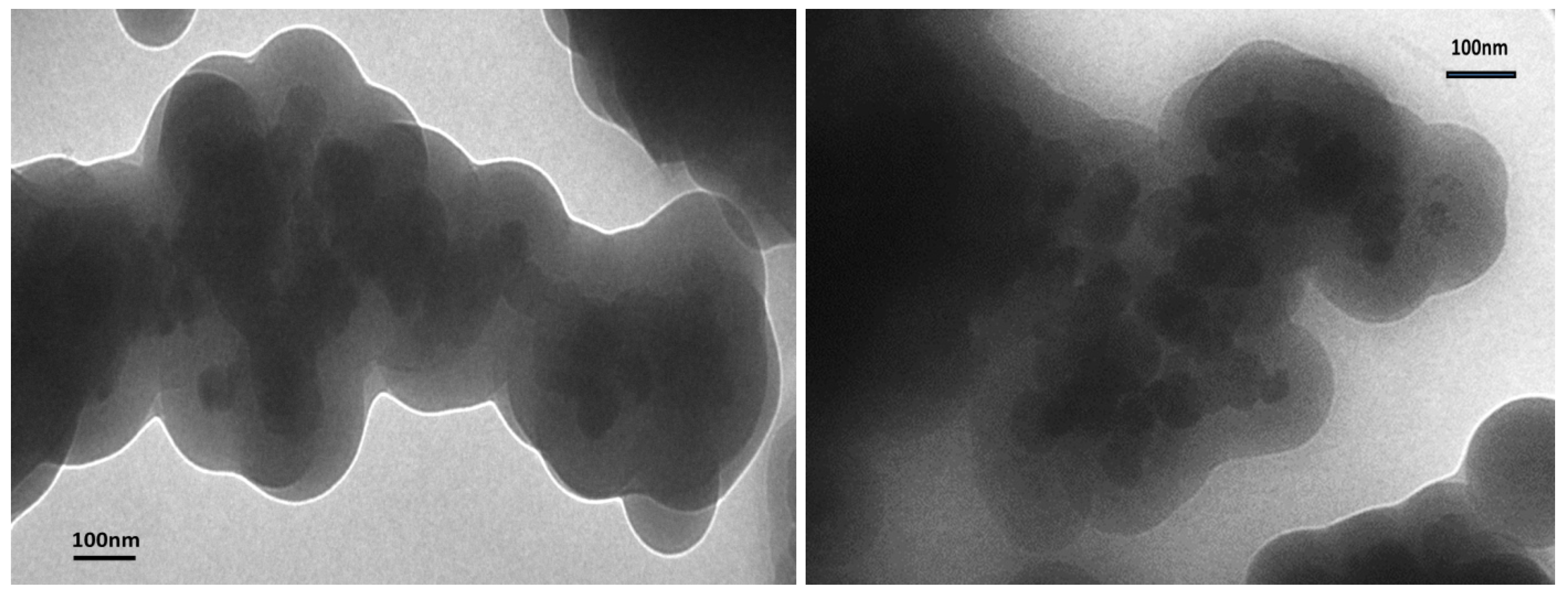

2.3. Synthesis and Characterization of CoFe2O4@SiO2@TiO2 Core-Shell Nanostructures



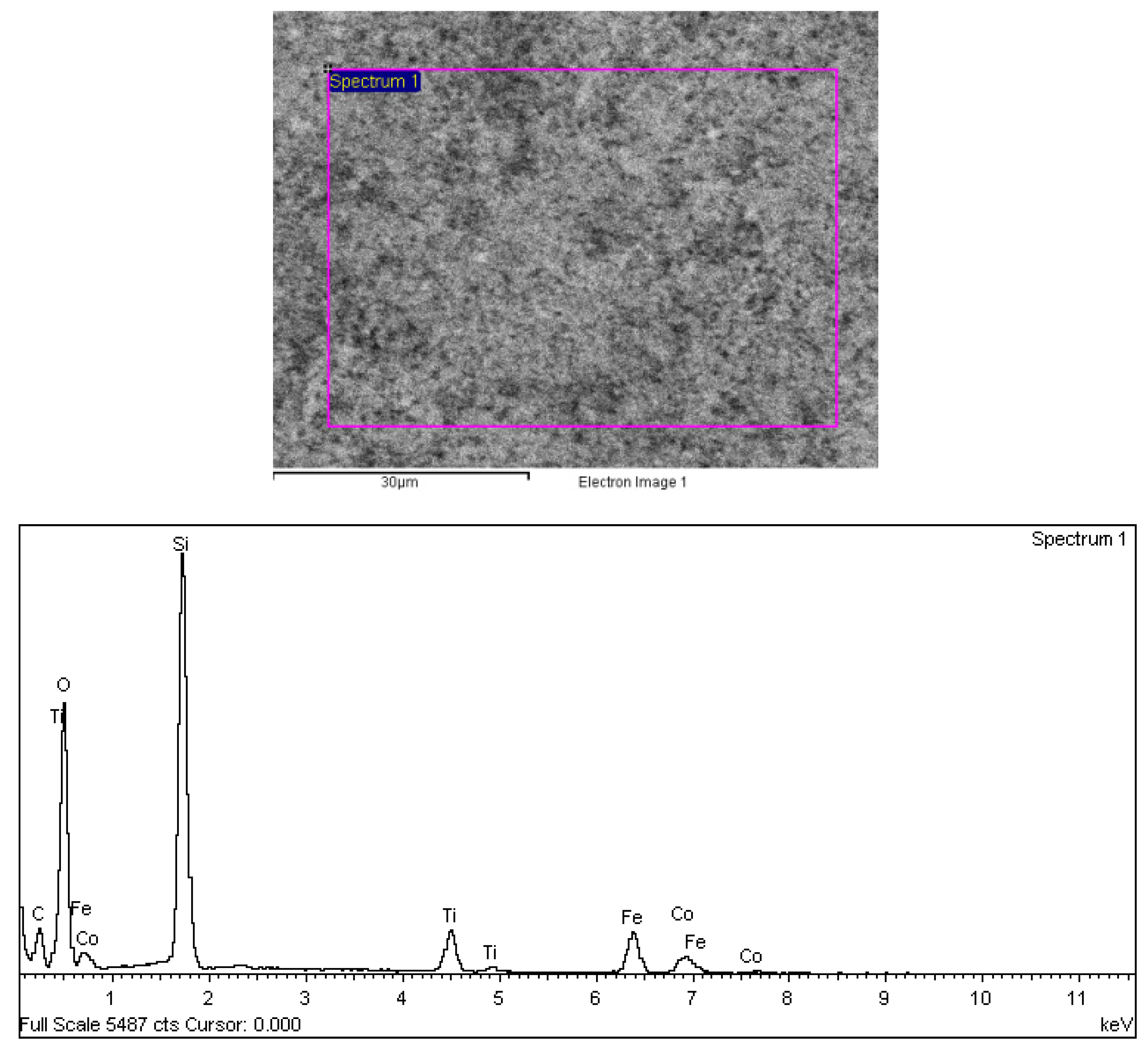
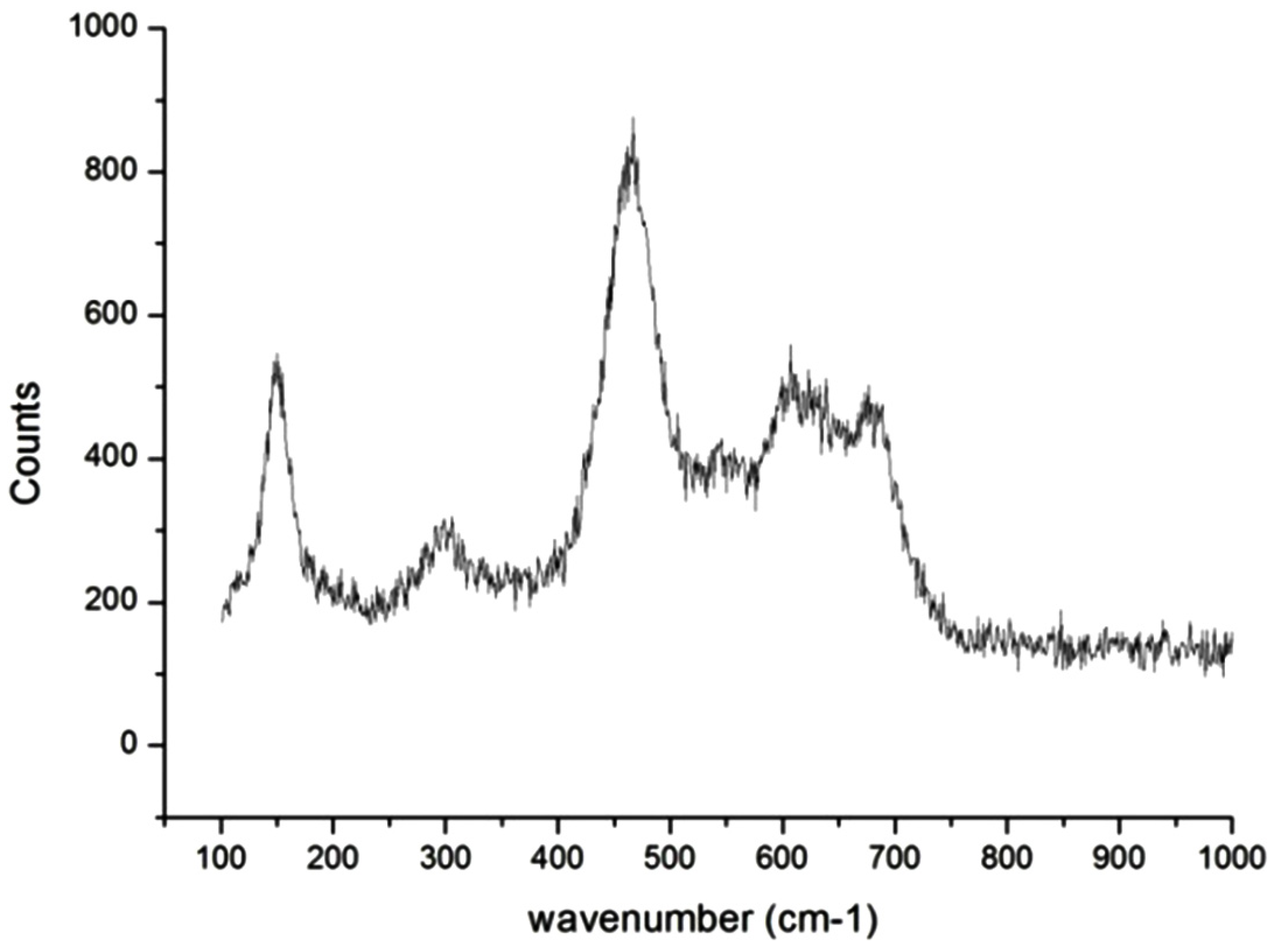
2.4. Photocatalytic Activity Testing of CoFe2O4@SiO2@TiO2 Core-Shell Nanoparticles
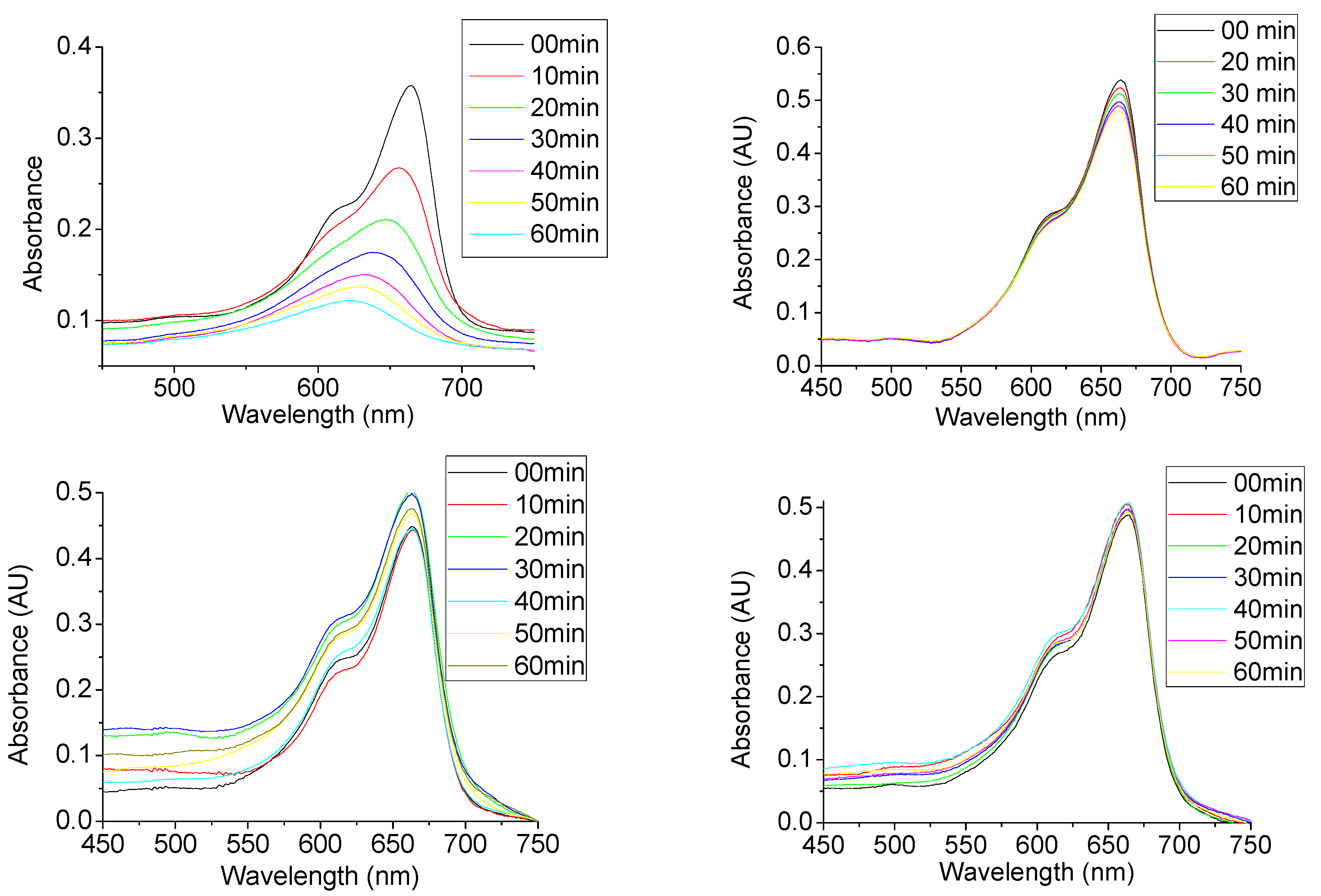

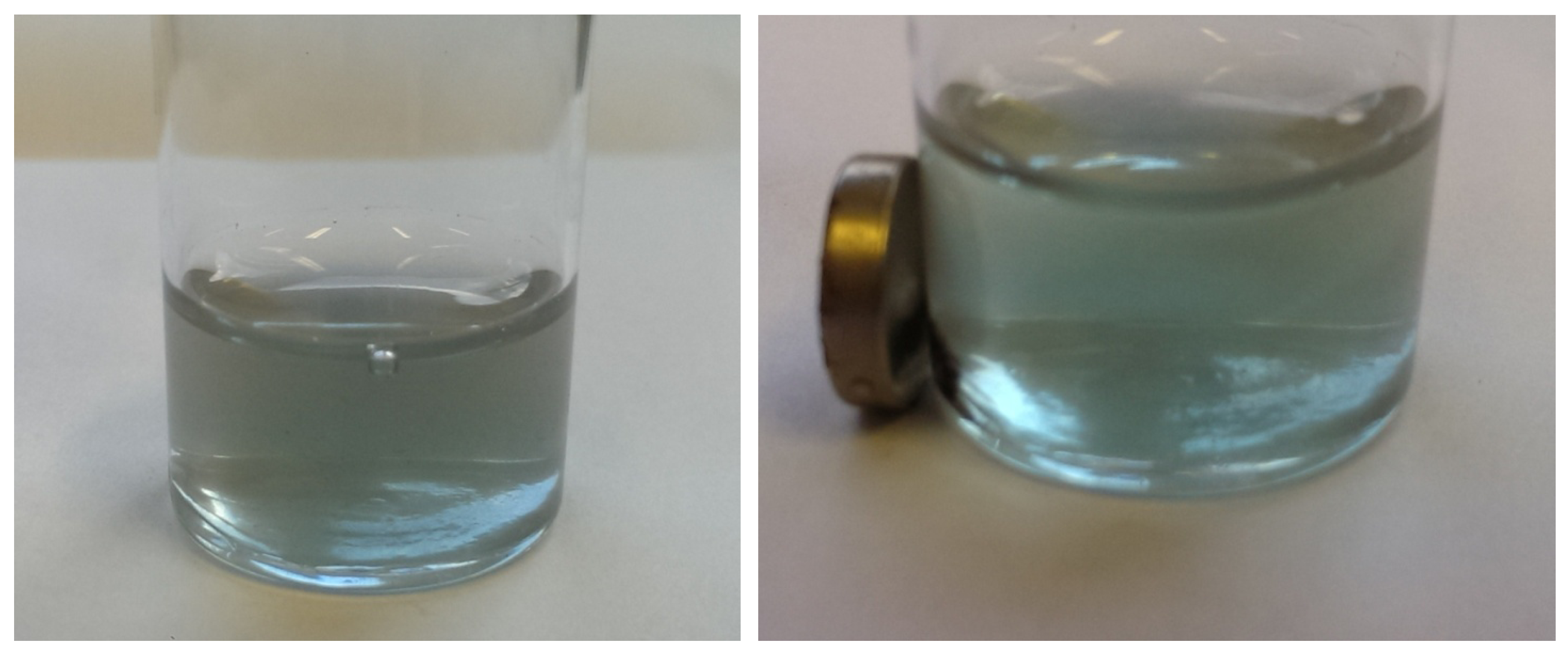
3. Experimental Section
3.1. General Procedures
3.2. Preparation of Cobalt Ferrite Nanoparticles in Aqueous Phase
3.3. Preparation of CoFe2O4@SiO2 Core-Shell Nanoparticles
3.4. Preparation of CoFe2O4@SiO2/TiO2 Core-Shell Nanostructures
3.5. Catalytic Activity Testing of TiO2 Coating
4. Conclusions
Acknowledgments
Author Contributions
Conflicts of Interest
References
- Wei, S.Y.; Wang, Q.; Zhu, J.H.; Sun, L.Y.; Lin, H.F.; Guo, Z.H. Multifunctional composite core-shell nanoparticles. Nanoscale 2011, 3, 4474–4502. [Google Scholar] [CrossRef]
- Chen, M.J.; Yang, W.T.; Yin, M.Z. Synthesis and applications of nanoparticles in biology. Prog. Chem. 2012, 24, 2403–2414. [Google Scholar]
- Clime, L.; Le Drogoff, B.; Zhao, S.; Zhang, Z.; Veres, T. Magnetic nanocarriers: From material design to magnetic manipulation. Int. J. Nanotechnol. 2008, 5, 1268–1305. [Google Scholar] [CrossRef]
- Corr, S.A.; Rakovich, Y.P.; Gun’ko, Y.K. Multifunctional magnetic-fluorescent nanocomposites for biomedical applications. Nanoscale Res. Lett. 2008, 3, 87–104. [Google Scholar] [CrossRef]
- Corr, S.A.; Gun’ko, Y.K.; Douvalis, A.P.; Venkatesan, M.; Gunning, R.D.; Nellist, P.D. From nanocrystals to nanorods: New iron oxide-silica nanocomposites from metallorganic precursors. J. Phys. Chem. C 2008, 112, 1008–1018. [Google Scholar] [CrossRef]
- Solinas, S.; Piccaluga, G.; Morales, M.P.; Serna, C.J. Sol-gel formation of γ-Fe2O3/SiO2 nanocomposites. Acta Mater. 2001, 49, 2805–2811. [Google Scholar] [CrossRef]
- Kodama, H.; Momose, S.; Sugimoto, T.; Uzumaki, T.; Tanaka, A. Chemically synthesized fept nanoparticle material for ultrahigh-density recording. IEEE Trans. Magn. 2005, 41, 665–669. [Google Scholar] [CrossRef]
- Yi, D.K.; Selvan, S.T.; Lee, S.S.; Papaefthymiou, G.C.; Kundaliya, D.; Ying, J.Y. Silica-coated nanocomposites of magnetic nanoparticles and quantum dots. J. Am. Chem. Soc. 2005, 127, 4990–4991. [Google Scholar]
- Zhang, M.; Cushing, B.L.; O’Connor, C.J. Synthesis and characterization of monodisperse ultra-thin silica-coated magnetic nanoparticles. Nanotechnology 2008, 19. [Google Scholar] [CrossRef]
- Fu, Q.T.; He, T.T.; Yu, L.Q.; Liu, Y.J.; Chai, Y.M.; Liu, C.G. Preparation and application of silica microspheres with magnetic core/mesoporous silica shell. Prog. Chem. 2010, 22, 1116–1124. [Google Scholar]
- Gleeson, O.; Davies, G.L.; Peschiulli, A.; Tekoriute, R.; Gun’ko, Y.K.; Connon, S.J. The immobilisation of chiral organocatalysts on magnetic nanoparticles: The support particle cannot always be considered inert. Org. Biomol. Chem. 2011, 9, 7929–7940. [Google Scholar] [CrossRef]
- Gleeson, O.; Tekoriute, R.; Gun’ko, Y.K.; Connon, S.J. The first magnetic nanoparticle-supported chiral dmap analogue: Highly enantioselective acylation and excellent recyclability. Chemistry 2009, 15, 5669–5673. [Google Scholar] [CrossRef]
- O’Dalaigh, C.; Corr, S.A.; Gun’ko, Y.; Connon, S.J. A magnetic-nanoparticle-supported 4-n,n-dialkylaminopyridine catalyst: Excellent reactivity combined with facile catalyst recovery and recyclability. Angew. Chem. Int. Edit. 2007, 46, 4329–4332. [Google Scholar] [CrossRef]
- Ansari, S.A.; Husain, Q. Potential applications of enzymes immobilized on/in nano materials: A review. Biotechnol. Adv. 2012, 30, 512–523. [Google Scholar] [CrossRef]
- Kneuer, C.; Sameti, M.; Haltner, E.G.; Schiestel, T.; Schirra, H.; Schmidt, H.; Lehr, C.-M. Silica nanoparticles modified with aminosilanes as carriers for plasmid DNA. Int. J. Pharm. 2000, 196, 257–261. [Google Scholar] [CrossRef]
- Pang, S.C.; Kho, S.Y.; Chin, S.F. Fabrication of magnetite/silica/titania core-shell nanoparticles. J. Nanomater. 2012, 2012. [Google Scholar] [CrossRef]
- Shi, Z.L.; Du, C.; Yao, S.H. Preparation and photocatalytic activity of cerium doped anatase titanium dioxide coated magnetite composite. J. Taiwan Inst. Chem. Eng. 2011, 42, 652–657. [Google Scholar] [CrossRef]
- Fu, W.; Yang, H.; Li, M.; Li, M.; Yang, N.; Zou, G. Anatase TiO2 nanolayer coating on cobalt ferrite nanoparticles for magnetic photocatalyst. Mater. Lett. 2005, 59, 3530–3534. [Google Scholar] [CrossRef]
- Chen, X.; Mao, S.S. Titanium dioxide nanomaterials: Synthesis, properties, modifications, and applications. Chem. Rev. 2007, 107, 2891–2959. [Google Scholar] [CrossRef]
- Fujishima, A.; Zhang, X.; Tryk, D.A. TiO2 photocatalysis and related surface phenomena. Surf. Sci. Rep. 2008, 63, 515–582. [Google Scholar] [CrossRef]
- Zhang, W.F.; He, Y.L.; Zhang, M.S.; Yin, Z.; Chen, Q. Raman scattering study on anatase TiO2 nanocrystals. J. Phys. D 2000, 33. [Google Scholar] [CrossRef]
- Diebold, U. The surface science of titanium dioxide. Surf. Sci. Rep. 2003, 48, 53–229. [Google Scholar] [CrossRef]
- Li, X.Z.; Li, F.B. Study of Au/Au3+-TiO2 photocatalysts toward visible photooxidation for water and wastewater treatment. Environ. Sci. Technol. 2001, 35, 2381–2387. [Google Scholar] [CrossRef]
- Peng, T.; Zhao, D.; Dai, K.; Shi, W.; Hirao, K. Synthesis of titanium dioxide nanoparticles with mesoporous anatase wall and high photocatalytic activity. J. Phys. Chem. B 2005, 109, 4947–4952. [Google Scholar] [CrossRef]
- Gong, X.-Q.; Selloni, A. Reactivity of anatase TiO2 nanoparticles: The role of the minority(001) surface. J. Phys. Chem. B 2005, 109, 19560–19562. [Google Scholar] [CrossRef]
- Lee, C.-T.; Lee, H.-Y.; Chen, H.-W. Gan mos device using SiO2 insulator grown by photoelectrochemical oxidation method. Electron Device Lett. 2003, 24, 54–56. [Google Scholar] [CrossRef]
- Biswal, D.; Peeples, B.N.; Peeples, C.; Pradhan, A.K. Tuning of magnetic properties in cobalt ferrite by varying Fe+2 and Co+2 molar ratios. J. Magn. Magn. Mater. 2013, 345, 1–6. [Google Scholar] [CrossRef]
- Baldi, G.; Bonacchi, D.; Innocenti, C.; Lorenzi, G.; Sangregorio, C. Cobalt ferrite nanoparticles: The control of the particle size and surface state and their effects on magnetic properties. J. Magn. Magn. Mater. 2007, 311, 10–16. [Google Scholar] [CrossRef]
- Hu, J.; Bando, Y.; Zhan, J.; Yuan, X.; Sekiguchi, T.; Golberg, D. Self-assembly of SiO2 nanowires and Si microwires into hierarchical heterostructures on a large scale. Adv. Mater. 2005, 17, 971–975. [Google Scholar] [CrossRef]
- Ohsaka, T.; Izumi, F.; Fujiki, Y. Raman spectrum of anatase, TiO2. J. Raman Spectrosc. 1978, 7, 321–324. [Google Scholar] [CrossRef]
- Zhang, J.; Li, M.; Feng, Z.; Chen, J.; Li, C. UV Raman spectroscopic study on TiO2. I. Phase transformation at the surface and in the bulk. J. Phys. Chem. B 2005, 110, 927–935. [Google Scholar] [CrossRef]
- Pang, S.C.; Kho, S.Y.; Chin, S.F. Fabrication of magnetite/silica/titania core-shell nanoparticles. J. Nanomater. 2012, 2012, 427310. [Google Scholar] [CrossRef]
© 2014 by the authors; licensee MDPI, Basel, Switzerland. This article is an open access article distributed under the terms and conditions of the Creative Commons Attribution license (http://creativecommons.org/licenses/by/3.0/).
Share and Cite
Greene, D.; Serrano-Garcia, R.; Govan, J.; Gun'ko, Y.K. Synthesis Characterization and Photocatalytic Studies of Cobalt Ferrite-Silica-Titania Nanocomposites. Nanomaterials 2014, 4, 331-343. https://doi.org/10.3390/nano4020331
Greene D, Serrano-Garcia R, Govan J, Gun'ko YK. Synthesis Characterization and Photocatalytic Studies of Cobalt Ferrite-Silica-Titania Nanocomposites. Nanomaterials. 2014; 4(2):331-343. https://doi.org/10.3390/nano4020331
Chicago/Turabian StyleGreene, David, Raquel Serrano-Garcia, Joseph Govan, and Yurii K. Gun'ko. 2014. "Synthesis Characterization and Photocatalytic Studies of Cobalt Ferrite-Silica-Titania Nanocomposites" Nanomaterials 4, no. 2: 331-343. https://doi.org/10.3390/nano4020331
APA StyleGreene, D., Serrano-Garcia, R., Govan, J., & Gun'ko, Y. K. (2014). Synthesis Characterization and Photocatalytic Studies of Cobalt Ferrite-Silica-Titania Nanocomposites. Nanomaterials, 4(2), 331-343. https://doi.org/10.3390/nano4020331





